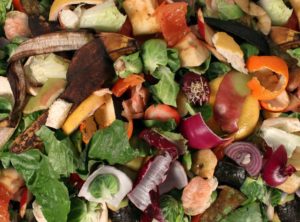Description
Most food scraps are tossed in the trash and eventually wind up in a landfill where food waste degrades in an anaerobic environment and is released as methane, a highly potent greenhouse gas (84 times more potent than CO2 over 20 years, 25 times more potent over 100 years). Approximately 23% of municipal solid waste generated in NY state consists of organics. Nationally, municipal landfills are the third largest source of human related methane emissions, accounting for approximately 14% of all methane emissions. The New York Climate Action Council Waste Advisory Panel has listed reducing food waste that is landfilled as among top five strategies to reduce current GHG emissions in New York State.
There are a number of strategies to divert food waste from landfills, such as;
- Baseline food waste volume in a locality and set food waste reduction targets.
- Increase food rescue efforts locally.
- Discourage food from being thrown away, such as through a pay-as-you-throw system.
- Collecting and recycling food waste.
The NYS Food Donation & Food Scraps Recycling law takes effect on January 1, 2022 and requires large generators of food scraps to donate excess edible food and recycle all remaining food scraps if they are within 25 miles of an organics recycler. Affected entities include those generating 2 tons or more of wasted food per week. Entities likely to be affected include colleges, full service restaurants, supermarkets, warehouse clubs, hotels, malls, conference centers, caterers, food distributors and wholesalers. The town of Bethlehem is currently the only municipal facility within the Capital Region that has a centralized facility capable of composting large quantities of food waste and is located within 25 miles of many affected entities in the region, particularly the City of Albany. Concerns have been raised that in order to avoid compliance, some entities may “dump” inappropriate, inedible or unsafe wasted food at food pantries and food banks. This law will increase demand for more centralized food waste collection and more food organics recycling facilities.
Strategies to encourage food diversion from the trash at the household scale can make a significant contribution to the reduction of methane emissions. Americans waste about a pound of food per person per day, and people who eat a diet rich in produce generate the most waste. Despite this volume, the NYS law currently excludes the food waste generated by households, local restaurants and smaller food markets. To meet NYS’s climate action goals, the NYS Climate Action Council Waste Advisory Panel is discussing amending the NYS Food Donation & Food Scraps Recycling law to include generators less than 2 tons/week , eventually down to the household scale. Currently, no municipalities in the Capital Region pick-up food waste as a municipal service nor do they require private trash haulers operating within their jurisdictions to collect food waste in a separate bin, as is required for other recyclables. Any composting of food waste by households or others is done voluntarily. Currently, only 4.8% of food waste is diverted from the waste stream and recovered for composting.
Municipal options to divert household food waste from landfills:
Backyard composting
This option is currently available for households that have outdoor space. The provision of low cost composters is currently offered by the town of Bethlehem to anyone in the region. More low cost composters and public education is necessary to increase participation.
Drop-off at community sites such as community gardens, farmers markets or farm stands for collection and reuse by gardeners or farmers in their composting operations
Drop-off sites exist at some community gardens and at a few farmers markets but more could be done. This option could be required in municipal permitting or licensing conditions.
Private haulers pick up food waste at curb-side for an additional fee and bring it to a centralized facility for composting
This option is available in a few municipalities in the Capital Region but most areas lack access to private haulers, and people may resist paying an additional fee on top of regular trash collection fees.
Pay as You Throw or “PAYT”, is a cost structure that bases the price of trash collection on volume, charging less for less trash
PAYT gives customers a price signal to divert food waste out of the trash system. This system only works if customers have alternative reasonable ways to dispose of food wastes, such as access to backyard composting, community drop-off sites or hauler pick-up.
Municipal provision of food waste disposal sites, at a centralized facility and/or at drop-off sites.
Municipal collection of food waste at curb-side
This option is available in some densely populated municipalities , such as San Francisco, and is typically done where the municipality is also responsible for trash collection. However, other examples are turning up. The town of Hamilton, MA bans food waste in trash and provides all residents with a countertop container and a curb-side bin for pick-up by a private hauler.
Add Food Scraps to Existing Yard Waste Composting Facilities
Some municipalities in the Capital Region already pick-up yard waste curbside for composting. Adding food scraps to yard trimming improves the Carbon to Nitrogen ratio of the compost and produces a superior and marketable product. However, it will take more equipment, manpower and disposal capacity to also pick-up food waste.
Benefits
Benefits of diverting food waste from landfills include:
- Compost is a recycled product used to replenish soil. It is best derived from a combination of yard waste and food waste. Yard waste sequesters carbon and food waste adds nitrogen for beneficial use as a natural fertilizer. Compost can replace the use of petroleum-based synthetic fertilizers. Its use as a soil amendment improves soil’s structure, its capacity for water retention, and its support for a higher quality of natural microbes. Compost as a soil amendment also suppresses the spread of plant disease reducing the use of synthetic pesticides, thereby supporting the growth of more nutritious crops. Food grown in composted soils is especially important for residents of low-income areas and “food deserts, ” places lacking access to grocery stores selling fresh produce
- Food waste diversion from trash will extend the life of municipal landfills.
- Household composting would lower local governments’ cost to manage solid waste.
- Local jobs to collect, process and market food waste compost can be created. Local entrepreneurs can start curb-side pick-up businesses and increase compost markets
- Potential to forge mutually beneficial collaborations between municipal food diversion programs and local farmers.
- Tipping fees on large food waste generators can be used to pay for programs for household food waste collection.
- The State will be offering technical assistance and grants to divert food scraps and develop new food waste composting facilities.

1
2
3
4
Implementation Phases
Baseline food waste volume in a locality and set food waste reduction targets.
Increase food rescue efforts locally.
Discourage food from being thrown away, such as through a pay-as-you-throw system.
Collecting and recycling food waste.
Challenges
The most challenging aspect is to change behavior and encourage people to separate food waste from the trash through education, accessibility to drop-off sites or pick-up services, price signals, and regulatory requirements.
Backyard composting is more suitable to rural and suburban areas or city dwellings that have backyards. Proper backyard composting takes knowledge. It may lack appeal for uninterested people or those with limited physical ability or the fortitude to compost in winter (e.g. the elderly).
There is a current lack of adequate capacity throughout the Capital Region to process significant quantities of food scraps and there is substantial cost to develop new infrastructure.
PAYT systems would need municipalities to require residential separation of food waste for pick-up. This would need to be codified and included as part of the permitting conditions for private waste haulers operating within the municipal jurisdiction. PAYT systems could work in urban, suburban and rural areas where backyard composting education is provided, community drop off sites exist or private haulers operate.
Town transfer stations would have to require customers to separate food waste and the food waste should be designated for recycling into compost either by the town or by another entity.
Example Municipalities
Several municipalities have already implemented this action…
- San Francisco passed it’s “zero waste” ordinance 100-09 in 2009 making it mandatory for all residents to separate compostables, recyclables and landfill trash and to participate in recycling and compostable programs with the aim of zero waste by the year 2020
- The City of Rye, New York is piloting a program for food composting. It consists of a public drop off area for composting as well as a pick up service for 150 households and intends to expand in scope in the coming years
- In New York City’s vision of a carbon free future, the city has initiated the GrowNYC Zero Waste Programs, which works to increase New York City’s curbside recycling program. GrowNYC Zero Waste’s “outreach efforts include weekly collections for food scraps and textiles, Stop ‘N’ Swap® community reuse events, event recycling assistance, and more”
Greenhouse Gas (GHG) Reductions
Data
Food waste generated per person per day: 1 pound [Food Waste in America: Facts and Statistics]
Population of Bethlehem, NY: 35093 [Data Commons Place Rankings]
Number of days per year: 365 days
CO2 emissions per pound of food waste: 3.8 lb [Earth Day50 Together We Can]
Percent reduction of emissions when food waste is used in composting : 84% [How cutting your food waste can help the climate]
Assumptions
Assuming everyone in Bethlehem, NY produced one pound of food waste every day.
Methodology
We calculated the:
- Food waste per day for Bethlehem, NY: 35093 lb/day
- Total food waste per year in Bethlehem, NY : 1202945 lb/year
- Amount of CO2 that is produced due to the food waste in a year: 48673990 lb/year
- Total CO2e reductions per year when food waste is used in composting
Result
18550 tons pf CO2e is reduced per year when all the food waste is used in composting.
This results in LARGE GHG emissions reductions.

Climate Smart Communities (CSC) & Clean Energy Communities (CEC) Link
This action is also related to several CSC actions for which municipalities can earn points toward certification. Municipalities can:
CSC Actions:
- Earn 2-16 CSC points by implementing the PE5 Action: Organics Management Plan, if their plan includes at least the following four elements: “a record of community engagement, the goals of the program, a list of the proposed organics management strategies, and an implementation timeline.”
- Earn 2 CSC points by implementing CSC’s PE5 Action: Compost Bins for Residents.
- Earn 2-22 CSC points by implementing CSC’s PE5 Action: Residential Organic Waste Program.
- Earn 1-3 CSC points for implementing CSC’s PE5 Action: Organic Waste Program for Government Buildings.

Co-benefits
There are multiple co-benefits to completing this action, including:
- Reduces GHG emissions from landfills.
- Composting increases soil health and reduced need for pesticides.
- Avoids unnecessary waste pick up.
- Extends life of landfills.
- Economic savings to municipalities.
- Avoided food waste.
Resources
https://climate.ny.gov/-/media/CLCPA/Files/2020-12-4-Waste-AP-Meeting–Presentation.pdf
https://www.dec.ny.gov/chemical/114499.html
www.theguardian.com/environment/2018/apr18/americans-waste-food-fruit-vegetables-study
https://www.dec.ny.gov/chemical/114499.html
SmartAsset.com
https://climate.ny.gov/-/media/CLCPA/Files/2021-01-27-Waste-Panel-Meeting-Notes.pdf
biocycle.net/massacchusetts-town-bans-food-waste-in-household-trash/
OCRRA.org
ILSR.org
https://www.nrdc.org/sites/default/files/food-waste-cities-policy-toolkit-report.pdf
http://www.ryesustainability.com/composting-initiative#started
https://www.wastetodaymagazine.com/article/composting-in-america-report-best-practices-pirg/
https://scrapfoodwaste.org/
https://wastedfood.cetonline.org/wp-content/uploads/2019/11/Community-Toolkit-Yard-Trimmings-Food-Scraps.pdf



